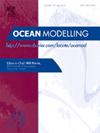极端天气下基于耦合神经网络和WAM的实时波模型误差校正
IF 2.9
3区 地球科学
Q2 METEOROLOGY & ATMOSPHERIC SCIENCES
引用次数: 0
摘要
准确预报波浪参数,特别是重要的浪高,对海上作业至关重要,但由于数值模式的误差迅速增长,在极端天气下预测浪高仍然很困难。本研究提出了一种基于时空注意力的神经网络与WAM波模型相结合的实时纠错框架。校正网络使用CFOSAT卫星观测进行训练,并通过Fortran-Python接口与WAM动态耦合。该系统应用于西北太平洋114个台风事件,与使用默认调谐参数的WAM预测相比,有效波高(SWH)均方根误差(RMSE)降低了24.6%,结构相似指数(SSIM)提高了26.3%。对墨西哥湾32个不同强度热带气旋的验证显示出很强的泛化能力,RMSE降低了47%,波谱精度提高了30%。这些结果突出了这种混合ai -物理框架的鲁棒性和可扩展性,展示了其在极端天气事件中实时海浪预报的实用价值。本文章由计算机程序翻译,如有差异,请以英文原文为准。
Real-time wave model error correction via coupled neural networks and WAM under extreme weather
Accurate forecasts of wave parameters, especially significant wave height, are essential for maritime operations, yet predicting wave heights during extreme weather remains difficult due to rapid error growth in numerical models. This study presents a real-time error correction framework that couples a spatiotemporal attention-based neural network with the WAM wave model. The correction network is trained using CFOSAT satellite observations and dynamically coupled with WAM via a Fortran–Python interface. Applied to 114 typhoon events in the Northwest Pacific, the system reduces significant wave height (SWH) root mean square error (RMSE) by 24.6 % and increases the structural similarity index (SSIM) by 26.3 %, compared to WAM predictions made with default tuning parameters. Validation across 32 tropical cyclones with diverse intensities in the Gulf of Mexico shows strong generalization, achieving up to a 47 % reduction in RMSE and enhancing wave spectral accuracy by >30 %. These results highlight the robustness and scalability of this hybrid AI-physics framework, demonstrating its practical value for real-time wave forecasting during extreme weather events.
求助全文
通过发布文献求助,成功后即可免费获取论文全文。
去求助
来源期刊

Ocean Modelling
地学-海洋学
CiteScore
5.50
自引率
9.40%
发文量
86
审稿时长
19.6 weeks
期刊介绍:
The main objective of Ocean Modelling is to provide rapid communication between those interested in ocean modelling, whether through direct observation, or through analytical, numerical or laboratory models, and including interactions between physical and biogeochemical or biological phenomena. Because of the intimate links between ocean and atmosphere, involvement of scientists interested in influences of either medium on the other is welcome. The journal has a wide scope and includes ocean-atmosphere interaction in various forms as well as pure ocean results. In addition to primary peer-reviewed papers, the journal provides review papers, preliminary communications, and discussions.
 求助内容:
求助内容: 应助结果提醒方式:
应助结果提醒方式:


